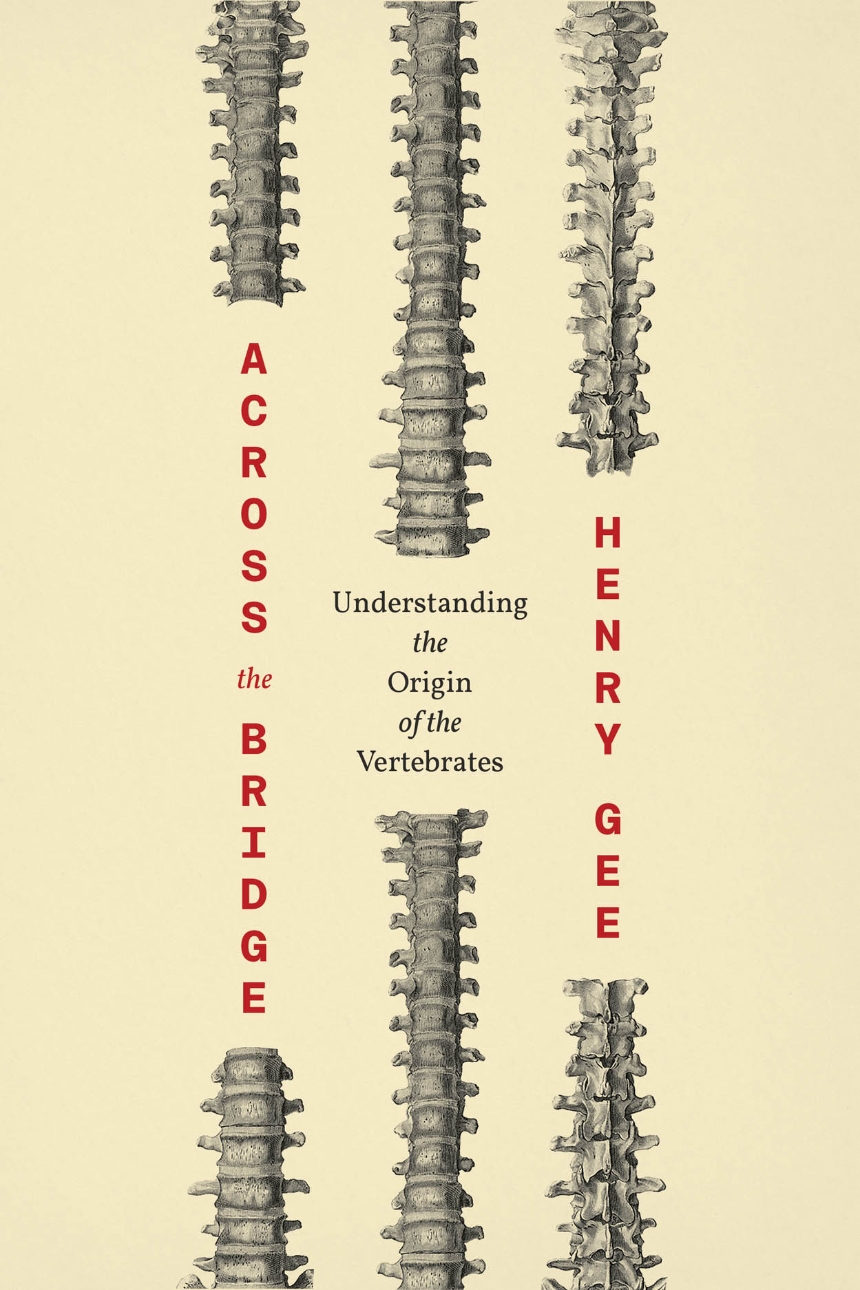Across the Bridge
Understanding the Origin of the Vertebrates
Our understanding of vertebrate origins and the backbone of human history evolves with each new fossil find and DNA map. Many species have now had their genomes sequenced, and molecular techniques allow genetic inspection of even non-model organisms. But as longtime Nature editor Henry Gee argues in Across the Bridge, despite these giant strides and our deepening understanding of how vertebrates fit into the tree of life, the morphological chasm between vertebrates and invertebrates remains vast and enigmatic.
As Gee shows, even as scientific advances have falsified a variety of theories linking these groups, the extant relatives of vertebrates are too few for effective genetic analysis. Moreover, the more we learn about the species that do remain—from sea-squirts to starfish—the clearer it becomes that they are too far evolved along their own courses to be of much use in reconstructing what the latest invertebrate ancestors of vertebrates looked like. Fossils present yet further problems of interpretation. Tracing both the fast-changing science that has helped illuminate the intricacies of vertebrate evolution as well as the limits of that science, Across the Bridge helps us to see how far the field has come in crossing the invertebrate-to-vertebrate divide—and how far we still have to go.
As Gee shows, even as scientific advances have falsified a variety of theories linking these groups, the extant relatives of vertebrates are too few for effective genetic analysis. Moreover, the more we learn about the species that do remain—from sea-squirts to starfish—the clearer it becomes that they are too far evolved along their own courses to be of much use in reconstructing what the latest invertebrate ancestors of vertebrates looked like. Fossils present yet further problems of interpretation. Tracing both the fast-changing science that has helped illuminate the intricacies of vertebrate evolution as well as the limits of that science, Across the Bridge helps us to see how far the field has come in crossing the invertebrate-to-vertebrate divide—and how far we still have to go.
Read the introduction.
288 pages | 19 halftones, 12 line drawings | 6 x 9 | © 2018
Biological Sciences: Biology--Systematics, Evolutionary Biology, Paleobiology, Geology, and Paleontology, Physiology, Biomechanics, and Morphology
Reviews
Table of Contents
Preface
Chapter One: What Is A Vertebrate? 1.1 Vertebrates in Context
1.2 What Makes a Vertebrate?
1.3 Breaking Branches
1.4 Summary
Chapter Two: Shaking the Tree 1.2 What Makes a Vertebrate?
1.3 Breaking Branches
1.4 Summary
2.1 Embranchements and Transformation
2.2 Evolution and Ancestors
2.3 Summary
Chapter Three: Embryology and Phylogeny 2.2 Evolution and Ancestors
2.3 Summary
3.1 From Embryos to Desperation
3.2 Genes and Phylogeny
3.3 Summary
Chapter Four: Hox and Homology 3.2 Genes and Phylogeny
3.3 Summary
4.1 A Brief History of Homeosis
4.2 The Geoffroy Inversion
4.3 The Phylotypic Stage
4.4 The Meaning of Homology
4.5 Summary
Chapter Five: What Is A Deuterostome?4.2 The Geoffroy Inversion
4.3 The Phylotypic Stage
4.4 The Meaning of Homology
4.5 Summary
Chapter Six: Echinoderms
Chapter Seven: Hemichordates
Chapter Eight: Amphioxus
Chapter Nine: Tunicates
Chapter Ten: Vertebrates
Chapter Eleven: Some Non-deuterostomes
Chapter Twelve: Vertebrates from the Outside, In
12.1 Introduction
12.2 The Organizer
12.3 The Notochord
12.4 Somitogenesis
12.5 Segmentation and the Head Problem
12.6 The Nervous System
12.7 Neural Crest and Cranial Placodes
12.8 The Skeleton
12.9 Summary
Chapter Thirteen: How Many Sides Has A Chicken? 12.2 The Organizer
12.3 The Notochord
12.4 Somitogenesis
12.5 Segmentation and the Head Problem
12.6 The Nervous System
12.7 Neural Crest and Cranial Placodes
12.8 The Skeleton
12.9 Summary
13.1 Introduction
13.2 The Enteric Nervous System
13.3 The Head and the Heart
13.4 The Urogenital System
13.5 The Gut and Its Appendages
13.6 Immunity
13.7 The Pituitary Gland
13.8 Summary
Chapter Fourteen: Some Fossil Forms 13.2 The Enteric Nervous System
13.3 The Head and the Heart
13.4 The Urogenital System
13.5 The Gut and Its Appendages
13.6 Immunity
13.7 The Pituitary Gland
13.8 Summary
14.1 Fossils in an Evolutionary Context
14.2 Meiofaunal Beginnings
14.3 Cambroernids
14.4 Vetulicystids
14.5 Vetulicolians
14.6 Yunnanozoans
14.7 Pikaia
14.8 Cathaymyrus
14.9 The Earliest Fossil Vertebrates
14.10 Conodonts
14.11 Ostracoderms and Placoderms
14.12 Summary
Chapter Fifteen: Breaking Branches, Building Bridges 14.2 Meiofaunal Beginnings
14.3 Cambroernids
14.4 Vetulicystids
14.5 Vetulicolians
14.6 Yunnanozoans
14.7 Pikaia
14.8 Cathaymyrus
14.9 The Earliest Fossil Vertebrates
14.10 Conodonts
14.11 Ostracoderms and Placoderms
14.12 Summary
15.1 Defining the Deuterostomes
15.2 Ambulacraria
15.3 Echinoderms
15.4 Hemichordates
15.5 Chordates
15.6 Amphioxus
15.7 The Common Ancestry of Tunicates and Vertebrates
15.8 Tunicates
15.9 Vertebrates
15.10 Cyclostomes
15.11 Gnathostomes
15.12 The Evolution of the Face
15.13 Crossing the Bridge
15.14 Conclusions
Notes15.2 Ambulacraria
15.3 Echinoderms
15.4 Hemichordates
15.5 Chordates
15.6 Amphioxus
15.7 The Common Ancestry of Tunicates and Vertebrates
15.8 Tunicates
15.9 Vertebrates
15.10 Cyclostomes
15.11 Gnathostomes
15.12 The Evolution of the Face
15.13 Crossing the Bridge
15.14 Conclusions
References
Index
